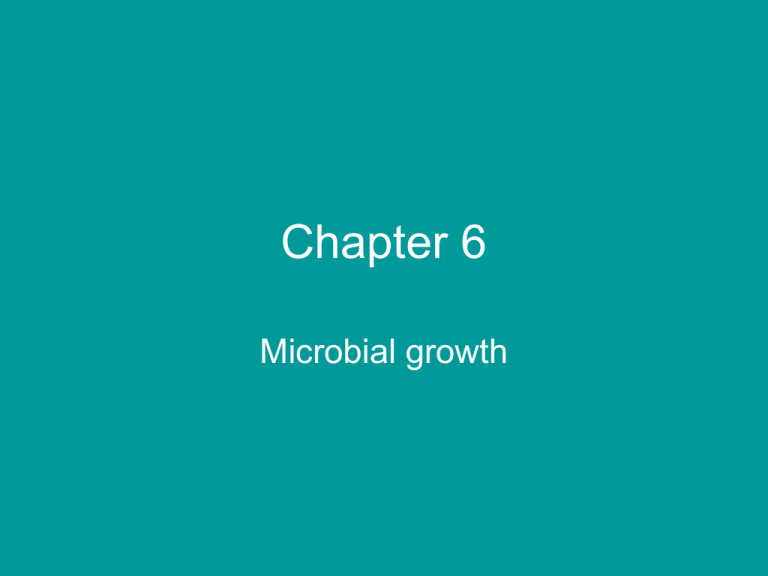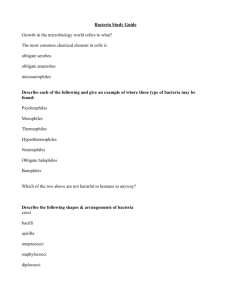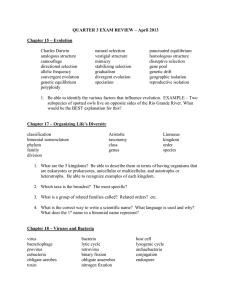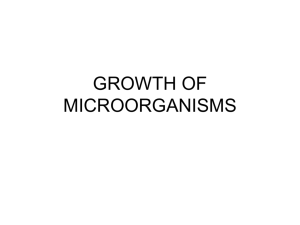Chapter 6 Microbial Growth
advertisement

Chapter 6 Microbial growth • Microbial growth – increase in the number of cells • Depends on environmental factor such as temperature. • Divided into groups based on their temperature requirement for growth • Microbial growth is also influenced by pH. • Optimum growth pH 6.5 to 7.5 • Acidophiles – like acidic pH • Sulfolobus – temperature 70oC pH 2 (thermophile) • Alkalophiles – basic pH • Nitrosomonas – pH 8 to 8.8 • Nitrosomonas – soil • Fungi – pH 5 to 6 • Osmotic environment • Most bacteria cannot survive in hypertonic environment. • Plamolysis • High concentration of salt is used to preserve food products. • Halophiles – need high concentration of salt for growth ( at least 30% salt) • Salt lakes, dead sea • Halobacterium • Facultative halophiles –can grow in an environment that has 2 to 15% salt. • Do not need high concentration of salt for growth. • Grow in the presence or absence of salt • Staphylococcus aureus Chemical requirement for growth • Carbon – backbone of the structures • Chemoheterotrophs – carbon and energy from organic molecules. E. coli • Chemoautotrophs – carbon from CO2 energy – inorganic molecules – sulfur Thiobacillus • Photoautotrophs = carbon from CO2 • Energy – sunlight, Cyanobacteria • Nitrogen – proteins, DNA, RNA • Amino acids, nitrate ions • Phosphorus – DNA, RNA, ATP, phospholipids • Phosphate ions • Sulfur proteins – sulfate ions Oxygen requirement • Obligate aerobes – need O2 for growth • Micrococcus • Facultative anaerobe – can grow in the presence or absence of O2. it grows better in the presence of O2. E.coli • Obligate anaerobe – only grow in the absence of O2. Clostridium • Cells use O2 during cellular respiration. • Small amount of toxic O2 – super oxide free radical is made – damage to the structures • Obligate aerobes and facultative anaerobes – enzymes to neutralize the toxic O2 • Super oxide dismutase (SOD) • Free radical – hydrogen peroxide (H2O2) • Catalase – H2O2 – water and oxygen • Aerotolerant anaerobes – tolerate O2 – do not use O2. Lactobacillus Microaerophiles • Need small amount of O2 for growth • Cannot grow in an O2 rich environment • Do not have enough enzymes to neutralize all the toxic O2 produced in an O2 rich environment. • Neisseria gonorrhoeae Culture Media • Chemically defined medium – know what is in the medium – how much of it is in the medium • Complex medium – know what is in the medium – do not know how much • Selective medium – prevents the growth of some bacteria – allows the growth of certain other bacteria • Used to isolate identify bacteria • Sabouraud dextrose agar – selective for fungi – pH 5.6 • Differential medium- one group from another • Blood agar – hemolytic bacteria – clearing of RBCs around the colony • Non hemolytic – no clearing of RBCs • Generation time – time it takes for one cell to divide into 2 • Depend on the environmental conditions and the species. • E.coli – 20 minutes • Mycobacterium leprae – 14 days • • • • • • Lag phase – no increase in the # cells. Cells are active – DNA, proteins, RNA Log phase – cells are actively dividing. Sharp increase in the number of cells Most sensitive to antibiotics – penicillin Stationary phase - #cells dividing equals the #cells dying. • Death phase - #cells dying exceeds the # new cells formed. Measurement of microbes • • • • • • • Plate count procedure Determine the #cells in a sample. Public health officials - #cells in milk Pasteurized – less than 30,000 cells/ml Unpasteurized – less than 50,000 cells/ml Plates – colonies between 25 to 250 Serial dilution • # of cells in a sample = # colonies X reciprocal of the dilution • 50 X10000 = 500,000 cells/ ml of milk





